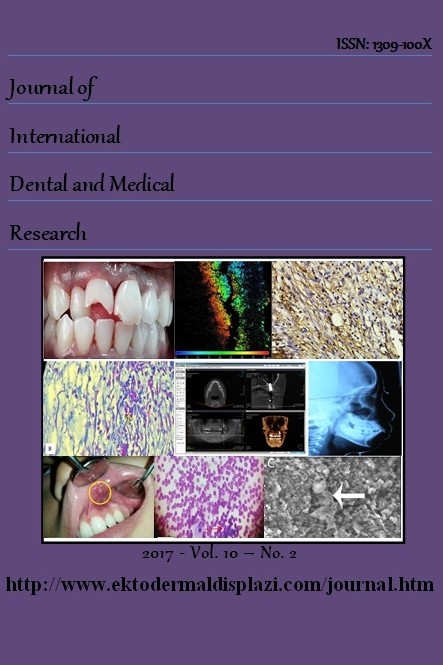Oral Candidal Carriage in Subgingival Sites and Its Subspecies Identification in Diabetic and Non-Diabetic Patients with Periodontitis
-
Oral Candidal Carriage in Subgingival Sites and Its Subspecies Identification in Diabetic and Non-Diabetic Patients with Periodontitis
Candidal carriage, diabetes periodontitis.,
___
- Rindum JL, Stenderup A, Holmstrup P: Identification of Candida albicans types related to healthy and pathological oral mucosa. J Oral Pathol Med 1994, 23:406-412.
- Janaina C.O. Sardi, Cristiane Duque, Flavia S. Mariano: Candida species in periodontal disease: a brief review. Journal of oral science, 2010, 52, 177-185.
- Fawad Javed, Lena Klingspor, Ulf Sundin:Periodontal conditions, oral Candida albicans and salivary proteins in type 2 diabetic subjects with emphasis on gender. BMC Oral Health, 2009, 9:12 .
- Janet H. Southerland, George W. Taylor,Steven Offenbacher : Diabetes and Periodontal Infection: Making the Connection. Clinical Diabetes October 2005vol. 23 no. 4 171-178. Levent Kardeşler, Nurcan Buduneli, Başak Bıyıkoğlu : Gingival crevicular fluid PGE 2 , IL1ß, t-PA, PAI-2 levels in type 2 diabetes and relationship with periodontal disease. Clinical Biochemistry, July 2008, vol 41, 863-868.
- Samarnayake L.P., Hughes A., Weetman D.A. (1986): Growth and acid production of candida species in human saliva supplemented with glucose. Journal of Oral Pathology, 15, 2512
- Critchley I.A. and DouglasL.J.(1987) :Role of glycosides as epithelial cell receptors for candida albicans. Journal of General Microbiology,133, 629-636.
- Ruchel R., Boening B., Borg M.(1986) : Characterization of secretory proteinase of candida parapsilosis and evidence for the absence of enzyme during infection in vitro. Infection and Immunity, 53, 411-419.
- Diamond R.D., Oppenheim F., Nakagawa Y.(1980): Properties of a product of candida albicans hyphae and pseudohyphae that inhibits contact between the fungi and human neutrophils in vitro. Journal of immunology, 125, 2797-2804.
- Rivas and Rogers, T.J.(1983): Studies on the cellular nature of Candida albicans-induced suppression. Journal of Immunology, 130, 376-379.
- Cuff C.F., Rogers C.M., Lamb B.J. (1986). Induction of suppressor cells in vitro by Candida albicans. Cellular Immunology, 100, 47-56.
- Lombardi G., Vismara D., Piccolella E. (1985): A non-specific inhibitor produced by Candida albicans activated T cells impairs cell proliferation by inhibiting interleukin-1 production. Clinical and Experimental Immunology, 60,303-310.
- Başlangıç: 2008
- Yayıncı: Ektodermal Displazi Grubu
Nisu SWASTİKA, Madhuri GAWANDE, Minal CHAUDHARY, Swati PATİL
Asok MATHEW, Aysha Rashed Ali Al ANSARİ, Ahmed Ali RADAİDEH, Nisha T VARUGHESE
A Survey on Dental Implant in Use Among UAE and Iranian Dentists
Ayad I.ISMAİL, Musab Hamed SAEED, Sara AFSHARİNİA
Oral Health Attitudes and Behavior Among Dental Students in Ajman, United Arab Emirates
Rehabilitation of Open Bite With Diastema Using Zirconia Ceramic Crowns: Case Report
Sedat GUVEN, Tahir KARAMAN, Mehmet UNAL, İhsan Cemal MELEK
The Usage of Low-Dose Lidocaine Fentanyl in Intravenous Regional Anesthesia
Abdulmenap GUZEL, Feyzi CELİK, Öznur ULUDAG, Erdal DOGAN, Celil ALEMDAR, Besir YİLDİRİM
Anesthetic Management of Pregnant Patients with Appendectomy
Feyzi CELİK, Abdullah OGUZ, Zeynep Baysal YİLDİRİM, Abdulmenap GUZEL, Erdal DOGAN, Taner CİFTCİ, İlker Onguc AYCAN
